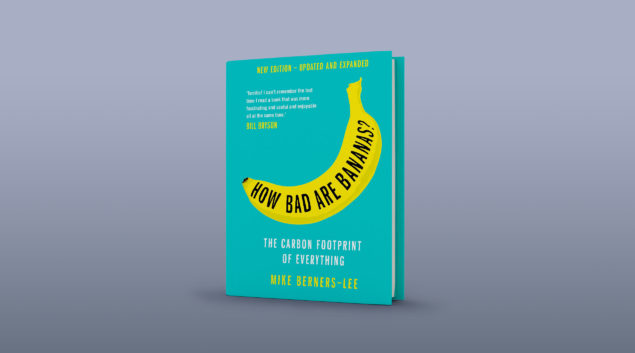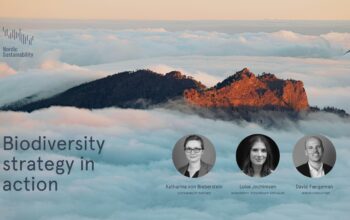
Today, we are diving into the world of carbon emissions with How Bad Are Bananas? by Mike Berners-Lee (yes, the brother of the Berners-Lee who invented the World Wide Web).
The carbon footprint of everything
We hear a lot about the environmental impact of driving and flying, but how about sending a text message, buying a latte, or even keeping a pet? How do apples compare to oranges or bananas, buying a newspaper to surfing on the internet, or cut flowers to house plants? These are some of the questions Berners-Lee set out to answer.
Carbon footprint is measured in CO2e, short for carbon dioxide equivalent. It’s a simplified approach to describing an object or activity’s contribution to global warming, and can be applied to all greenhouse gases. According to Berners-Lee, CO2e is the best estimate for assessing the total climate change impact, as it considers both direct and indirect emissions.
Less than 10 grams to billions of tonnes of CO2e
Berners-Lee argues that in a sense, carbon is like money.
As a result of living in a society where everything has monetary value, people develop a sense of financial proportion from an early age. This allows them to make economically sound choices and most of the time, we know how much things cost, even without looking at the price tag. Our instinct when it comes to carbon emissions needs to be similarly attuned. But unlike money, many of us have a hard time grasping how much carbon we emit, as we physically can’t see neither the CO2 itself nor the consequences that it gives rise to.
“If we’re serious about really addressing climate change, we need to become energy and carbon literate and get to grips with the underlying structures of the things we consume. There is no substitute for cutting our carbon footprints.” – How Bad Are Bananas?
Berners-Lee takes us on an educational journey of discovering everything from the carbon footprint of a pint of water to the world’s combined annual emissions. It’s an eloquent examination, or at the very least a highly qualified “guestimate”, of the carbon footprint of pretty much everything you could think of.
Contrary to what one might expect, it turns out that bananas aren’t all that bad – but do beware of heated greenhouses, also known as hothouses. Tomatoes grown in a hothouse emit 26.9 kg more carbon per kg than tomatoes grown locally and in season.
The 5-tonne lifestyle
One way of thinking about the carbon footprint of an object or activity, is by putting it in the context of a year’s worth of 5-tonne CO2e living. Berners-Lee clarifies that while this isn’t a feasible goal for everyone on the planet, it would already be a big step if widely adopted in Europe.
So what exactly can you do with a “budget” of 5 tonnes of CO2e a year? Let’s break this down. A large cheeseburger (3.2 kg CO2e), for example, equals six hours worth of a 5-tonne year. If you drive a thirsty petrol car for 1,000 miles (1.3 tonnes CO2e), this will consume just over a three months’ ration. One premium economy return flight from London to Hong Kong burns around 4.5 tonnes CO2e, leaving you with just 500 kg CO2e left to be spent for the rest of that year. If you’re on a meat-heavy diet, you might use your 5 tonnes solely on food and drinks. Lastly, if you insulate a loft, it is equivalent to a whopping 8 years’ worth of a 5-tonne budget.
This might leave you wondering whether there are better ways of spending your carbon budget.
Berners-Lee offers a simple four-step guide to cutting your own emissions.
- Step 1: Understand your own carbon footprint by dividing it in a pie chart overview.
- Step 2: Pick your battles, know how ready you are to make different types of changes and how much effort you’re prepared to put in.
- Step 3: Get started on the different pieces of the pie that you laid out in step 1, and begin thinking about your behavior within each slice. How you can reduce the carbon footprint of the things you do and buy?
- Step 4: Pick the actions you are going to start with – and include at least one big one. While you start cutting your own carbon footprint as described in step 3, it’s also time to push for change within your social circle. Whether it’s by talking to friends and family, by writing to your local council, or by protesting in the streets – make sure you make it count.
With How Bad are Bananas?, Berners-Lee has made a brilliant contribution to improving carbon literacy. The first edition came out in 2010, but as nothing stays still these days, he in 2020 published an updated version taking into account new developments, such as the cheaper price of renewable energy. His book has sparked insightful conversations in our office and our homes, as it is a book that guests often pick out from the bookshelf and flip through the pages of – just as it was designed to.
Although we at Nordic Sustainability found Berners-Lee’s work exceptional, we still grapple with the notion of being able to live 5-tonne lifestyle – but nothing worthwhile ever comes easy, right?



